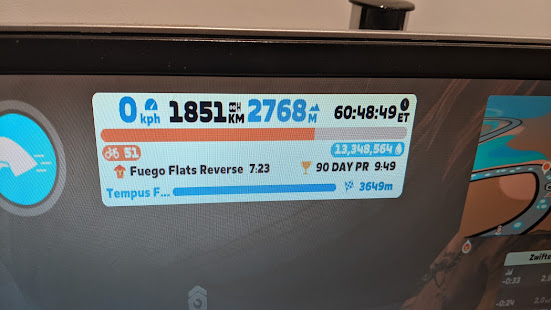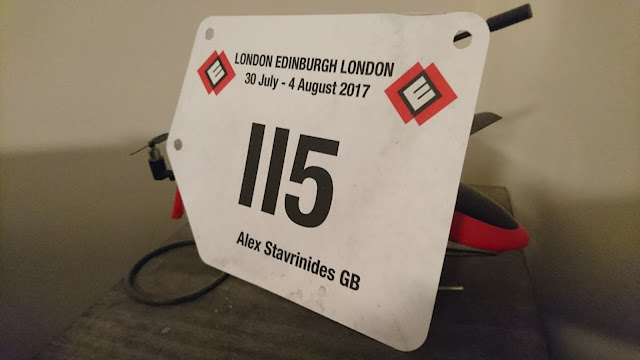Pre-christmas Loughborough University testing
On December 23rd, while
everyone else in the office was scoffing mince pies, making sure the family vat
of Roses had been emptied and having another round of high sugar sweets, I was
on my calorie counted program. Why? To make sure that as the year
progressed I can replicate my day to nullify as many dietary effects as
possible. As testing on December the 23rd will be replicated again, I
don't want to try and find mince pies in June.
By mid-day when others
were drifting home to their families, I met up with Lynsey to do my first round
of testing - FTP testing. We had hoped to include a VO2 max test at this
point too, however tech gremlins crept in to stop the program running.
Still, we'd have a benchmark to work from.
First off was
anthropometric testing - height and mass and skin fold tests.
In terms of results, I
have (had) a body mass of 70.3 kg and a height of 175.8 cm. The mass will
be variable, but at the age of 34 the height will be more hard set. My
mass naturally fluctuates by around a kilogram depending on food intake,
hydration and defecation but will be an area open to challenge. For
context with the UK population, the Office of National Statistics states that
the average UK male is 38 years old and 175.3cm in height, therefore I am very
average. In terms of mass, the average UK male is 83.6 kg so I am
underweight compared to the average male. On the simplistic BMI equation
of mass over the square of my height, I have a BMI of 22.7 (within the health
range) compared to the average UK male of 27.2 (over weight). By
definition, my height and mass are "average."
Stature wise, I was skin
folded across 8 locations (tricep, sub-scapular, bicep, illiac crest,
supraspinale, abdominal, front thigh and medial calf) and my girth measured at
3 (waist, gluteal and calf).
For reference to where I
was being drawn on and pinched:
Source: http://www.linear-software.com/online.html
In superficial vanity,
I'm the typical skinny cyclist - I'm not going to be winning nay body building
comps. Analytically, I look like this:
To take the skin fold
numbers into something more meaningful and comparative, there are two ways of
looking at the result.
Based on the sum of 7 skinfolds, my value is 39.5 mm (tri, bi, sub.scap., subraspinale, ab., front thigh and calf). Compared to a high-performance Under-23 road cyclist, they would have an expected body mass of around 73.4 kg (± 6.8 kg) and a ∑7 skinfold value of 45.1 mm (± 8.8 mm). A senior track endurance cyclist would come in at 72.6 kg (± 4.4 kg) and 38.1 mm (± 5.1 mm).
Based on the sum of 7 skinfolds, my value is 39.5 mm (tri, bi, sub.scap., subraspinale, ab., front thigh and calf). Compared to a high-performance Under-23 road cyclist, they would have an expected body mass of around 73.4 kg (± 6.8 kg) and a ∑7 skinfold value of 45.1 mm (± 8.8 mm). A senior track endurance cyclist would come in at 72.6 kg (± 4.4 kg) and 38.1 mm (± 5.1 mm).
As a skin fold to % body fat conversion (and the value that everyone always looks at as the headline figure)
the % body fat gives 6.5% based on the Yuhasz equation.
What does a skinny Dr
Stav look like in action? Gratuitous
action shot time.
Ok, I’m wrapped up well
here, but approximately in the same form at the Frew Whitton in May 2015.
Anthropometric conclusion/recommendations
I’m pretty much in line
with the expected for someone with my motivations, aspirations and road bike
experience. I am below the average national
mass for my height, but that’s not surprising.
Physically I am average by height and weight for a healthy male.
So recommendations from
Lynsey:
1) Maintain body weight
2) Increase muscle mass particularly in lower body and reduce excess
body fat from upper body.
Performance data and lactate threshold (LT)
A bit of background. The lactate threshold (LT) data in
conjunction with the anthropometric data
will give a number of matrix which will help baseline, measure improvement and
predict performance. Essential the
higher the LT the longer I will be able to put power through the pedals and
onto the road – the more power, the more potential speed and/or longer until
exhaustion. The lactate value is crucial
as it shows at what point my body can no longer counter balance the change in
pH of my blood as lactate is produced by the muscles – this is my buffering
potential. Sticking at a power output
below the LT would allow me to maintain performance for a longer time period
but at a slower speed. Going above it I
may have burst of speed but I will fatigue quicker. By training to increase my buffering capacity
I will be able to increase my LT therefore sustain higher power outputs (and
speeds) for longer. As the LT will
determined through interrogation of the curve (Thank you Lynsey!), the point at
which my lactate changes will correlate to my Functional Power Threshold – how much
power can I produce before the LT.
This
test was a 35 Watts ramp of 3 minutes per power setting starting at 95 Watts and seeing when I could no
longer maintain my rhythm while having a blood test and score card at the end
of each section. Simple. The results look like
this.
From this, it can be
shown that my lactate threshold occurs around the 180 Watts mark. This equates to a 2.6 W/kg output at LT. My maximum output was 268 Watts in this
test. Now I could use every excuse under
the sun here (I’d recently been ill, it’s the end of the season, the room was
too hot, I had a spot in an awkward place etc) but this isn’t an amazing
score. It’s more human then chasing the
wheel of Big Mig in a TT. For comparison,
expect a pro cyclist to be much higher.
For some data (again, cycling blogs are fantastic for error prone data
and famously bias) the likes of Froome may have a 30 minute critical power of
around 393 W or 5.7 W/kg. Makes me
rather pedestrian.
I would like to go to
VO2 data here, but as this will be done shortly, I think it would be
better to hold off for now.
Heart
rate data.
As the power ramps, so
does heart rate until a plateau and heart rate max. Based on my predicted HRmax by 220-age I should have a predicted max of 186 bpm. This is a very rough estimation rather than a hard fast number as human variabilty can skew this value significantly. In reality (with the exception of sensor
error), I have rarely seen my HRmax approach this value. Typical HRmax is more likely to be in the order of around 165-170 bpm. From the testing conducted, my heart rate was
taken at the end of each power setting as shown.
From this, my heart
rate at lactate threshold is 146 bpm or 78% of my predicted HRmax. However based on the maximum heart rate of
the observed data (168 bpm), LT was reached at 87% of my “true” HRmax.
Not included in the
testing is my resting heart rate. At a
morning resting rate, my current minimum heart rate is around 43 bpm. This gives a heart rate range of 125 bpm. This is below the population expected resting
heart rate but symptomatic of someone who has done a fair amount of sport.
How
much pain?
For the final set of
results, at each power setting I stated my Rating of Perceived Exertion (RPE) on
a 4 – 20 scale based on how far I felt. This may be subjective (I’m sure more egotistical
men would down play the pain) so I tried to answer honestly. From the power of LT I rated the RPE as 14 – “somewhat
hard.” This suggest I still felt fairly
comfortable at the LT. In my own opinion
(and I’m sure Lynsey may have other ideas) I tend to think of the RPE scale
more logarithmic – although it is painful, I kind of like going to the LT or
beyond but think the area above LT ramps much quicker than below LT. This isn’t an area I know enough sport
science about, but I know Wyrnose Pass Hard Knot pass is a 20 (and then some!).
LT,
HRmax and RPE summary.
In LT terms, I have
work to do but the base line is now drawn.
On my own crude data analysis from 2015, my performance ramped through
the spring to an early summer peak, ebbed slightly then re-peaked late
summer/early autumn based on my average speeds and freshness feel. The point I am/was at during this testing is
above the 2015 start point – my 180 W or 2.6 W/kg is the lowest I should be
through the next 7 months. May be I
under performed in the test due to XYZ or it’s a true reflection – only repeated
testing will show.
For pushing into this
challenge, I am expecting my LT to increase with training therefore aiding my
speed and ability to resist fatigue. At
some point there will be a natural ceiling to this value but at the moment
there is certainly head room.
For HRmax it
will be interesting to see how this chances.
Although my actual was below my theoretical, my range is shifted lower
and I don’t recall accurately seeing my actual ever approaching my theoretical. Time will tell.
This data is giving the
targeted information required for the next steps. VO2 max testing will come in the
next day’s/weeks but from this data, heart rate zoning for training will be
refined. Unfortunately I don’t have the
training budget for power cranks or meters, therefore heart rate zone (rather
old skool) will be the method of choice to push the LT curve to the right as
far as possible by July the 9th.
Close.
In closing, firstly a
massive thank you to Lynsey for putting me to the test – all this data and
analysis is coming from her work using me as a case study, so thank you. I can’t wait to see how this changes over the
coming months. Where will my fat go? How
much power can I produce? How long until I bonk? How much sweat will pour onto
the lab floor?
Secondly, my physical
form is part of the whole project equation.
I’ll address this in another post but equipment choice will also
factor. Even at a low LT of 180 W using
a Pashley is going to be very different to a road bike so I am looking at where
I can make my FTP work most efficiently for me, but that is yet to come.
Ride on! Dr Stav.









Comments
Post a Comment